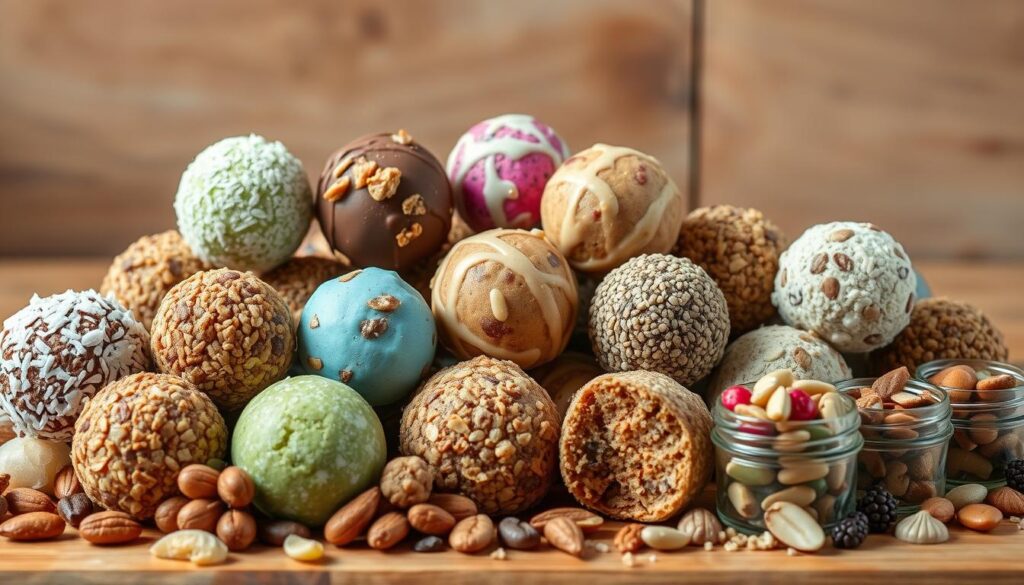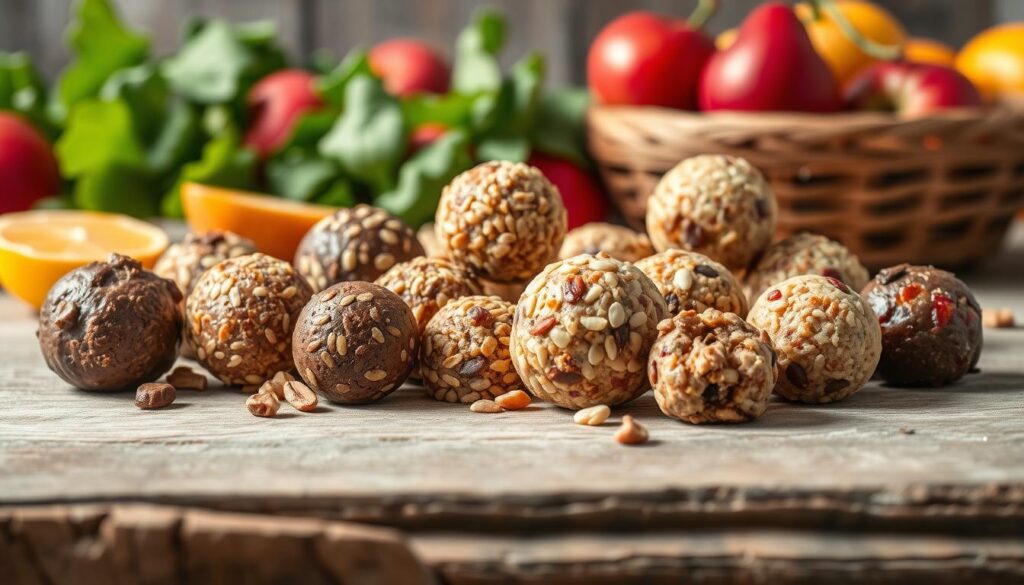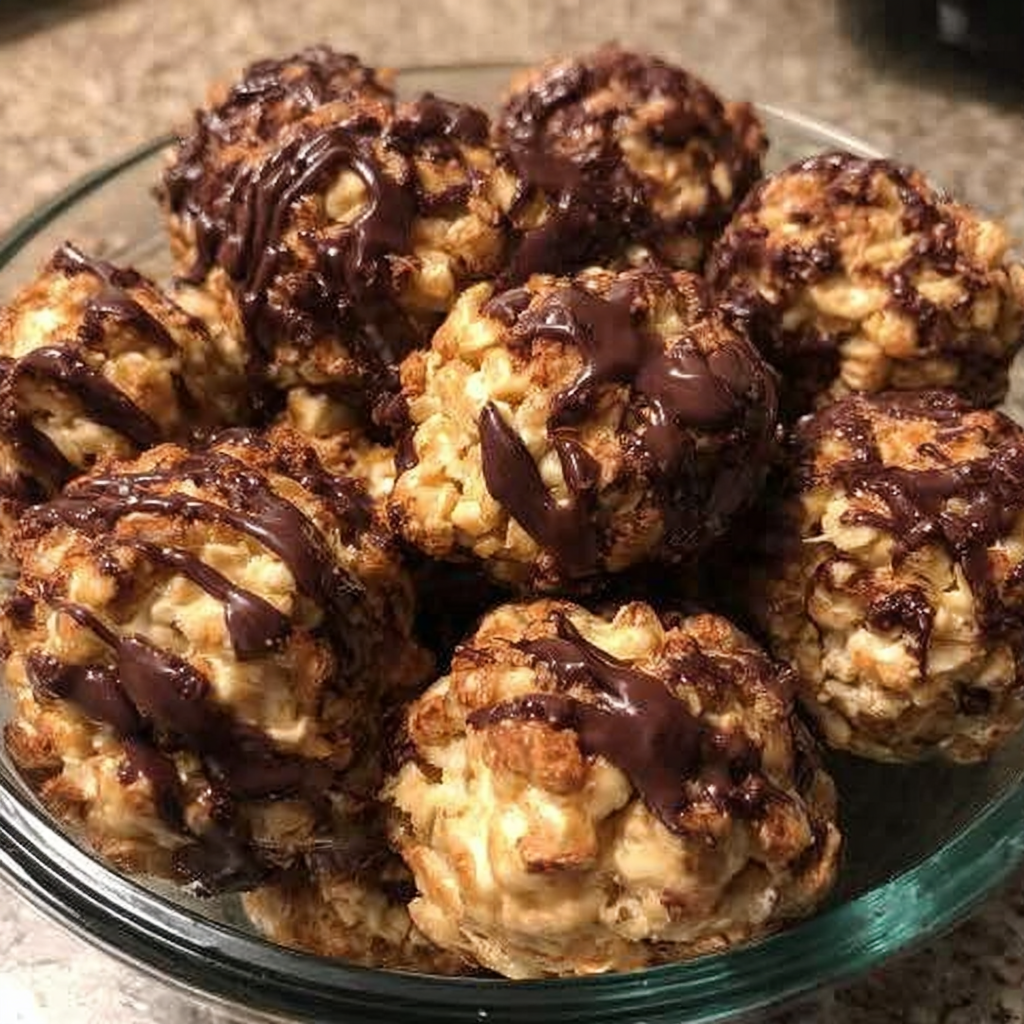As you consider incorporating energy balls into your daily routine, it’s essential to understand the ideal daily intake for optimal health benefits. Energy balls have become a popular nutritious snack, and knowing how many to consume is crucial for your well-being. Your daily intake of energy balls should be guided by a reliable nutritional guide to ensure you’re getting the most out of these energy-boosting treats.
By following a well-structured nutritional guide, you can determine the perfect daily intake of energy balls for your needs, helping you maintain a balanced diet and reap the benefits of these convenient snacks. Your energy balls daily intake will depend on various factors, including your activity level and dietary goals, making it important to find a balance that works for you and your lifestyle.
Understanding What Energy Balls Are
Energy balls have become a popular snack choice due to their convenience and nutritional value. You can find them in various types, made with different energy ball ingredients such as nuts, dried fruits, and superfoods. These ingredients contribute to the nutritional profile of energy balls, providing a mix of macronutrients and micronutrients.
The nutritional composition basics of energy balls typically include a balance of carbohydrates, protein, and healthy fats. This balance is what makes energy balls a great option for a quick energy boost. When considering the types of energy balls, you can choose from protein-packed, fruit-based, or keto-friendly varieties, each with its own unique nutritional value.
- Nuts like almonds and walnuts
- Dried fruits such as cranberries and raisins
- Superfoods like chia seeds and coconut flakes
These ingredients not only add natural sweetness and texture but also provide a range of health benefits. By understanding the different types of energy balls and their energy ball ingredients, you can make informed choices about which ones to include in your diet.
With so many options available, it’s easy to find energy balls that fit your dietary needs and preferences. Whether you’re looking for a quick snack or a post-workout energy boost, energy balls are a convenient and nutritious choice. Their nutritional value and variety of types make them a great addition to a healthy diet.
| Type of Energy Ball | Energy Ball Ingredients | Nutritional Value |
|---|---|---|
| Protein-Packed | Nuts, seeds, protein powder | High protein, moderate carbohydrates |
| Fruit-Based | Dried fruits, honey, oats | High carbohydrates, moderate fiber |
| Keto-Friendly | Nuts, seeds, coconut flakes | High fat, low carbohydrates |
The Benefits of Daily Intake of Energy Balls in Your Diet
When it comes to healthy snacking, energy balls are an excellent option. They provide a convenient and nutrient-dense way to curb your hunger and satisfy your cravings. The energy ball benefits are numerous, and they can be a great addition to your daily diet.
Some of the key advantages of energy balls include:
- Providing sustained energy throughout the day
- Supporting workout recovery and muscle growth
- Offering a healthy alternative to traditional sweets and snacks
- Aiding in portion control and weight management
By incorporating energy balls into your diet, you can experience the benefits of healthy snacking and improve your overall well-being. Energy balls are made with nutrient-dense foods such as nuts, seeds, and dried fruits, which provide a boost of energy and support overall health.
In addition to their nutritional value, energy balls are also convenient and easy to consume on-the-go. They can be made at home using a variety of ingredients and can be customized to suit your dietary needs and preferences. Whether you’re looking for a quick snack or a post-workout treat, energy balls are a great option.
Your Daily Intake of Energy Balls Should You Eat a Day
When it comes to energy ball serving size, the general guideline is to consume 1-3 energy balls per day. This daily consumption can vary depending on your activity level, overall diet, and specific health goals. For instance, if you’re an athlete, you may need more energy balls to support your energy needs, while a sedentary person may require fewer.
To determine the right energy ball serving size for you, consider the following factors:
- Activity level: If you’re highly active, you may need more energy balls to replenish energy stores.
- Overall diet: If your diet is lacking in certain nutrients, energy balls can help fill the gap.
- Health goals: If you’re trying to lose weight or manage blood sugar, you may need to adjust your energy ball intake accordingly.
It’s also important to be aware of overconsumption signs, such as excessive calorie intake or digestive discomfort. If you experience any of these symptoms, it may be a sign that you’re eating too many energy balls.
By paying attention to your body and adjusting your energy ball intake accordingly, you can enjoy the benefits of these nutritious snacks while avoiding potential negative effects. Remember, the key is to find a balance that works for you and your unique needs.
Caloric Content of Different Energy Ball Varieties: Recommended energy ball servings
When it comes to energy ball calories, it’s essential to consider the ingredients used to make them. A nutritional comparison of homemade and store-bought energy balls reveals that the calorie count can vary significantly. For instance, energy balls made with nuts, dried fruits, and added sweeteners tend to be higher in calories.
To make informed decisions about your energy ball consumption, it’s crucial to practice calorie counting. This involves being mindful of the ingredients and portion sizes. Here are some examples of energy ball varieties and their approximate calorie counts:
- Homemade energy balls with oats, nuts, and dried fruits: 120-150 calories per ball
- Store-bought energy balls with added sweeteners: 150-200 calories per ball
- Energy balls made with coconut flakes and dark chocolate: 100-120 calories per ball
As you can see, the calorie content of energy balls can range from 100 to over 200 calories per ball, depending on the ingredients used. By being aware of these differences, you can make better choices about your energy ball consumption and ensure that you’re meeting your daily calorie needs.

Remember, energy balls can be a nutritious and convenient snack option, but it’s essential to consider their caloric content as part of your overall diet. By practicing calorie counting and making informed choices, you can enjoy energy balls while maintaining a balanced diet.
| Energy Ball Variety | Calorie Count (per ball) |
|---|---|
| Homemade with oats and nuts | 120-150 |
| Store-bought with added sweeteners | 150-200 |
| Coconut flakes and dark chocolate | 100-120 |
Best Times for your Daily Intake of Energy Balls
When it comes to getting the most out of your energy balls, timing is everything. As a pre-workout snack, energy balls can provide a quick burst of energy to help you power through your exercise routine. The combination of complex carbohydrates, protein, and healthy fats in energy balls makes them an ideal choice for a pre-workout boost.
After your workout, energy balls can also play a crucial role in post-workout nutrition. The nutrients in energy balls can help to replenish energy stores, support muscle recovery, and aid in the repair of muscle tissue. By consuming energy balls at the right time, you can optimize your energy ball timing and get the most out of your workout.
Optimizing Energy Ball Timing
To get the most out of your energy balls, consider the following snack timing strategies:
- Eat an energy ball 30-60 minutes before your workout to provide a energy boost
- Consume an energy ball within 30-60 minutes after your workout to aid in recovery
- Space out your energy ball consumption throughout the day to maintain stable energy levels
By incorporating energy balls into your daily routine and optimizing your energy ball timing, you can experience the benefits of improved energy levels, enhanced workout performance, and support for overall health and wellness.
| Timing | Benefits |
|---|---|
| Pre-workout | Provides energy boost, enhances workout performance |
| Post-workout | Aids in recovery, replenishes energy stores, supports muscle repair |
| Throughout the day | Maintains stable energy levels, supports overall health and wellness |
Storage and Freshness Guidelines
To keep your energy balls fresh and maintain their nutritional value, it’s essential to store them properly. Energy ball storage can be done in various ways, including refrigeration and freezing. The shelf life of energy balls typically ranges from a few days to several weeks, depending on the ingredients and storage method.
Here are some freshness tips to help you enjoy your energy balls at their best:
- Store energy balls in an airtight container to maintain freshness
- Keep them in the refrigerator to extend shelf life
- Freeze energy balls for longer storage, up to 2-3 months
- Check for signs of spoilage, such as mold or an off smell, before consuming
By following these energy ball storage tips, you can ensure that your energy balls remain fresh and nutritious. Remember to always check the shelf life of your energy balls and consume them before they expire. With proper storage and handling, you can enjoy your energy balls as a healthy and convenient snack.
For more information on energy ball storage and freshness tips, consider consulting with a registered dietitian or a reputable health resource. They can provide you with personalized advice and guidance on how to maintain the freshness and nutritional value of your energy balls.
| Storage Method | Shelf Life |
|---|---|
| Refrigeration | 1-2 weeks |
| Freezing | 2-3 months |
Incorporating Energy Balls into Your Meal Plan
When it comes to meal planning, it’s essential to consider healthy breakfast options and snack ideas that can provide a boost of energy throughout the day. Energy balls can be a great addition to your meal plan, offering a convenient and nutritious way to satisfy your hunger and support your overall well-being.
To incorporate energy balls into your meal plan, start by thinking about your breakfast options. You can pair energy balls with yogurt parfaits or smoothie bowls for a healthy and filling breakfast. For snack ideas, consider combining energy balls with other nutritious foods like fruits, nuts, or carrot sticks with hummus.
Breakfast Options
- Yogurt parfaits with energy balls and granola
- Smoothie bowls with energy balls and fresh fruit
- Energy ball and avocado toast
Snack Combinations
- Energy balls with apple slices and almond butter
- Energy balls with carrot sticks and hummus
- Energy balls with trail mix and dried fruit
By incorporating energy balls into your meal planning, you can create a balanced and nutritious diet that supports your overall health and well-being. Remember to consider your individual calorie needs and adjust your energy ball intake accordingly. With a little creativity, you can enjoy energy balls as a healthy breakfast option or snack idea that fits into your busy lifestyle.
| Meal Plan Idea | Energy Ball Pairing |
|---|---|
| Breakfast | Yogurt parfait with energy balls and granola |
| Snack | Energy balls with apple slices and almond butter |
| Post-Exercise | Energy balls with banana and peanut butter |
Special Dietary Considerations for Daily Intake of Energy Balls
When it comes to energy balls, you can easily adapt them to fit your dietary needs and restrictions. Whether you’re looking for vegan energy balls that don’t use honey or other animal products, gluten-free options for those with celiac disease or gluten sensitivity, or keto-friendly recipes for a low-carb diet, the flexibility of energy ball recipes is a major advantage.
Some popular ingredients used in vegan energy balls include nuts, seeds, and dried fruits. You can also experiment with different types of nut butters and coconut oil to add flavor and texture. For gluten-free options, consider using gluten-free oats or replacing oats with almond flour or coconut flakes. If you’re following a keto diet, focus on using keto-friendly recipes that incorporate healthy fats like coconut oil, nuts, and seeds.

To make energy balls that cater to your dietary needs, consider the following tips:
- Choose ingredients that align with your dietary restrictions
- Experiment with different flavors and textures
- Keep your energy balls fresh by storing them in an airtight container
By being mindful of the ingredients and portion sizes, you can enjoy energy balls that not only taste great but also support your overall health and wellness goals.
Making Your Own Energy Balls at Home
Creating homemade energy balls can be a fun and rewarding experience, allowing you to control the ingredients and nutritional content. With a few simple ingredients and some basic recipe guidelines, you can make your own energy balls at home. To get started, you’ll need a combination of rolled oats, nuts, seeds, and dried fruits. You can also add in optional ingredients like coconut flakes, cinnamon, or honey to give your energy balls a unique flavor.
When it comes to portion control, it’s essential to create consistently sized energy balls. This will help you track your intake and ensure you’re getting the right amount of nutrients. Here are some tips for portion control:
- Use a small cookie scoop or spoon to portion out the mixture
- Make a batch of energy balls and store them in an airtight container
- Label the container with the date and ingredients used
By following these tips and using a basic energy ball recipe, you can create your own homemade energy balls and enjoy the benefits of portion control. Some popular energy ball recipes include peanut butter and honey, chocolate chip, and cranberry orange. You can also experiment with different ingredients and flavors to create your own unique energy ball recipes.
Tips for Perfect Homemade Energy Balls
Remember, making your own energy balls at home is all about experimentation and creativity. Don’t be afraid to try new ingredients and flavors, and have fun with the process. With a little practice and patience, you can create your own delicious and healthy energy balls that meet your dietary needs and preferences.
| Energy Ball Recipe | Ingredients | Portion Control Tips |
|---|---|---|
| Peanut Butter and Honey | 2 cups rolled oats, 1 cup peanut butter, 1/2 cup honey | Use a small cookie scoop, store in an airtight container |
| Chocolate Chip | 2 cups rolled oats, 1 cup chocolate chips, 1/2 cup nuts | Make a batch and label the container, use a spoon to portion out the mixture |
Common Mistakes to Avoid When Consuming Energy Balls
When incorporating energy balls into your diet, it’s essential to be aware of common mistakes that can hinder your progress. Energy ball mistakes can lead to overconsumption, poor food storage, and unhealthy eating habits. To avoid these pitfalls, let’s explore some key considerations.
One of the primary energy ball mistakes is treating them as a low-calorie food or using them to replace whole meals. This can lead to an imbalanced diet and negatively impact your overall health. Instead, focus on maintaining healthy eating habits by consuming energy balls in moderation and as part of a balanced meal plan.
Overconsumption Pitfalls
Overconsumption of energy balls can occur when you don’t store them properly. Food storage is crucial to maintaining the quality and freshness of energy balls. Leaving them at room temperature for too long or not sealing them properly can lead to spoilage and waste.
To avoid these mistakes, consider the following tips:
- Store energy balls in an airtight container in the refrigerator to maintain freshness.
- Consume energy balls within a few days of preparation to ensure optimal quality.
- Be mindful of portion sizes to avoid overconsumption.
By being aware of these common mistakes and taking steps to avoid them, you can enjoy energy balls as a healthy and convenient snack while maintaining healthy eating habits and proper food storage.
| Mistake | Consequence | Solution |
|---|---|---|
| Overconsumption | Imbalanced diet | Consume in moderation |
| Poor food storage | Spoilage and waste | Store in airtight container |
Health Considerations and Warnings
When it comes to energy balls, maintaining a nutrient balance is crucial. While they can be a healthy snack, relying too heavily on them can lead to an imbalanced diet. It’s essential to consider your overall dietary needs and ensure you’re getting a variety of nutrients from different food sources.
Individuals with allergies should be cautious when consuming energy balls, as they often contain common allergens like nuts and seeds. Always read labels or know the ingredients to avoid any adverse reactions. If you have specific dietary restrictions, such as gluten-free or vegan, be sure to choose energy balls that meet your needs.
- Consult with a healthcare professional or registered dietitian for personalized advice on incorporating energy balls into your diet.
- Be mindful of portion sizes to avoid overconsumption.
- Choose energy balls made with wholesome ingredients to ensure you’re getting the most nutritional benefits.
By being aware of these health considerations and warnings, you can enjoy energy balls as a healthy and convenient snack while maintaining a balanced diet.
Homemade Energy Balls
Ingredients
- 1 cup rolled oats
- ½ cup nut butter peanut butter, almond butter, or cashew butter
- ⅓ cup honey or maple syrup for natural sweetness
- ½ cup chopped nuts almonds, walnuts, or pecans
- ¼ cup seeds chia seeds or flaxseeds
- ⅓ cup dried fruits raisins, cranberries, or dates
- 1 teaspoon vanilla extract for flavor
- ¼ cup dark chocolate chips optional, for added sweetness
Instructions
- In a large bowl, combine rolled oats, nut butter, honey (or maple syrup), chopped nuts, seeds, dried fruits, and vanilla extract.
- Mix well until all ingredients are evenly combined.
- If the mixture is too dry, add a small amount of water or more nut butter to help bind it together.
- Using your hands or a small cookie scoop, shape the mixture into bite-sized balls.
- Place the energy balls on a parchment-lined tray and refrigerate for at least 30 minutes to firm up.
- Store the energy balls in an airtight container in the refrigerator for up to 1-2 weeks or freeze for longer storage.
Notes
Nutrition
Conclusion: Creating Your Perfect Energy Ball Routine
As you’ve learned, energy balls can be a fantastic addition to your personalized nutrition and balanced diet as part of a healthy lifestyle. By understanding the benefits, moderation, and versatility of these nutrient-dense snacks, you can create your own perfect energy ball routine that supports your individual needs and goals.
Whether you prefer a pre-workout boost, a post-exercise recovery treat, or a satisfying mid-day pick-me-up, energy balls offer a convenient and delicious way to fuel your body. Remember, the ideal intake can vary from person to person, so be mindful of your body’s signals and adjust your consumption accordingly.
As you move forward, we encourage you to experiment with different ingredients, flavors, and serving sizes to find the energy ball formula that works best for you. Enjoy these nutritious bites as part of your overall wellness journey, and let them contribute to your long-term health and vitality.
FAQ
What are the common ingredients in energy balls?
Energy balls typically contain a combination of nuts, seeds, dried fruits, oats, and other nutrient-dense ingredients. These provide a balance of healthy fats, proteins, and carbohydrates to fuel your body.
What are the nutritional benefits of energy balls?
Energy balls are packed with essential vitamins, minerals, and antioxidants that can support your overall health and wellbeing. They are a great source of sustained energy, and can also aid in post-workout recovery.
How Many Daily Intake of Energy Balls should I eat per day?
The recommended serving size for energy balls is typically 1-3 per day, depending on your individual dietary needs and activity level. Factors like your caloric intake, health goals, and the specific ingredients in the energy balls can all affect the ideal daily portion.
What is the caloric content of different energy ball varieties?
The caloric content of energy balls can vary widely based on the ingredients used. Homemade versions tend to be lower in calories than store-bought options, which may contain added sugars or oils. It’s important to check the nutritional information and adjust your servings accordingly.
When is the best time for the Daily Intake of Energy Balls?
Energy balls can be enjoyed at various times throughout the day, depending on your needs. They make an excellent pre-workout snack, providing a quick energy boost. They can also be a great post-exercise option, helping to replenish nutrients and aid in recovery.
How should I store energy balls to keep them fresh?
For optimal freshness, store your energy balls in an airtight container in the refrigerator. This can help extend their shelf life by up to one week. You can also freeze energy balls for longer-term storage, up to 3 months.
Can energy balls be tailored to fit special dietary needs?
Absolutely! Energy balls can be easily customized to accommodate various dietary restrictions and preferences, such as vegan, gluten-free, or keto-friendly. The flexibility of energy ball recipes allows you to create options that cater to your specific nutritional requirements.
What are some common mistakes to avoid with Daily Intake of Energy Balls
Overconsumption and improper storage are two of the most common mistakes with energy balls. It’s important to be mindful of portion sizes and to store them properly to maintain their freshness and nutritional value.

